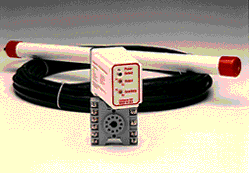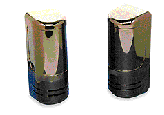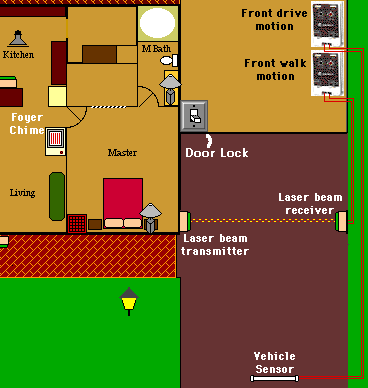

 Typical vehicle sensor and control unit.
|
 Typical laser beam transmitter and receiver. |

|
The Powerflash modules and the power transformers for the laser beam and the vehicle sensor are located in one place, perhaps on a single "power strip"? Here, the Laser beam transmitter can possibly get its power from the walkway or maybe through the wall from the 'Master' bedroom. The vehicle sensor actually has a small 'control box' that goes between the sensor and the Powerflash. |
|
--This script monitors the front driveway sensor -- If it goes ON, something is moving there. -- If it's status is true, there may yet be motion? if time delta of "Front Walk Motion" is less than 30 then turn off "Driveway Floods" in 20 write log "Possible vehicle leaving" else turn on "Foyer Chime" turn on "Driveway Floods" for 2 * minutes write log "Vehicle entering driveway" end if |
--when the motion sensor 'relaxes', we get an OFF -- this means 'no motion seen for a while'. -- We need to make sure we didn't miss the ON ! if status of "Front Drive Motion" is false then if time delta of "Front Walk Motion" is less than 30 then turn off "Driveway Floods" in 20 else turn on "Foyer Chime" turn on "Driveway Floods" for 2 * minutes write log "Vehicle entering driveway - missed the ON" end if end if |
|
--If motion is sensed at the front walkway turn on "Front Walk Light" --maybe someone's driving in? if time delta of "Front Drive Motion" is greater than 30 then turn on "Foyer Chime" write log "Movement on the front walkway" else write log "A vehicle has arrived" end if |
--things get still again, we get an OFF -- this is a backup, did we miss the ON ? if status of "Front Walk Motion" = false then turn on "Front Walk Light" --maybe someone's coming in? if time delta of "Front Drive Motion" is greater than 30 then turn on "Foyer Chime" write log "Movement on front walk, missed the ON" else write log "A vehicle has arrived, missed the ON" end if end if |
|
Back to Home Page |
Tutor Index |
Two-Button dimmer |
Copyright 2007, Sand Hill Engineering All rights reserved.
![]()
Last modified: May 8, 2002
Michael Ferguson, webmaster@shed.com